A handy resource on the internet is Flags Of The World: which, long before sites such as Wikepedia, was an exponent of collective learning and the sharing of expertise. I have been on and off again, active on the site and its mailing list.
The debate over the colors of the Philippine flag has been discussed in its page on the Philippines and the FOTW mailing list. But it bears pointing out that the flag family to which our flag belongs -the flags of the Philippines, Cuba, and Puerto Rico- all have a problem with the definition of the color blue. Part of it stems from the same reasons we have a problem with ours: hanky-panky on the part of flag manufacturers; a lack of documentation; and the problem of the flags being originally designed with the United States in mind.
First, by using illustrations from FOTW, let’s look at the Cuban, Philippine, and Puerto Rican flags:
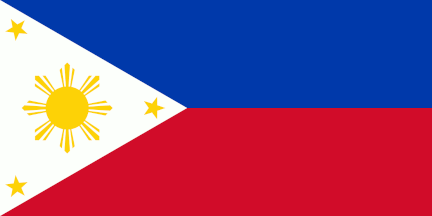
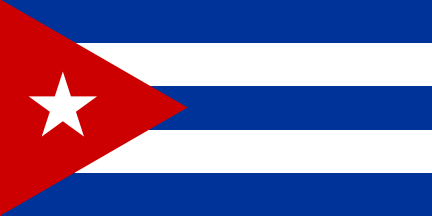
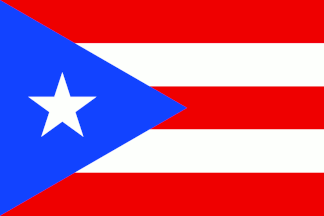
The Philippine flag; The Cuban flag; The Puerto Rico flag
Designed and adopted in 1898 Designed in 1849, adopted, 1902 Designed in 1895, adopted 1905
Notice, first of all, what they have in common. The general design of a triangle in the corner, and then stripes. Also, the use of the colors red, white, and blue. Second, note that Cuba’s is the oldest design, and the almost certainly, Cuba’s flag was the model for that of the Philippines and Puerto Rico. Cuba’s revolution was an inspiration to Filipino revolutionaries in many ways (Rizal wanted to go there under cover of being a surgeon, to study how the fighting was going on; the Cuban constitution was studied by Filipino revolutionaries; American interest in the Cuban cause was considered a good omen for the Filipino cause).
Now here’s something curious about the flag history of Cuba. From FOTW comes this quote.
Cuba:
From Barraclough and Crampton: Flags Of the World (1981) [brc81]: “A Venezuelan general, Narciso López, made in 1848 the first serious attempt to help Cuba break away from Spanish rule. He carried ‘La Estrella
Solitaria’ -‘The Lone Star’-banner, Cuba’s present flag. (While he was having important meetings on the revolution, his wife embroidered it). His attempt was not successful; only in 1902 Cuba became an independent republic and López’s flag was adopted as the official flag. The three blue stripes are the symbols of the original three provinces. The triangle is a masonic symbol, here signifying liberty, equality and fraternity. The red color is for the blood sacrificed by the Cuban patriots.
Jarig Bakker, 29 October 1998
So we know that the triangle, a symbol of Masonry and the French Revolution, became a Masonically-inspired part of ours, because of a Venezuelan working for Cuban independence. Now here comes an even more curious part. First, look at this:
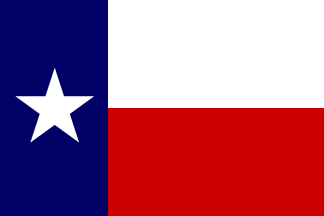
The flag of the Republic of Texas (1836-1839) and of the State of Texas
This, apparently, was the model for not one, but two flags for Cuba. In Cuba, FOTW explains the relationship of the Texan flag to the 1849 flag:
Crampton’s ‘World of Flags’, 1990, has: “The white star (La Estrella Solitaria) represented a new state to be added to the USA. The red, white, and blue also referred deliberately to the Stars and Stripes.” (p. 32)
Eve Devereux, in: ‘Flags, the illustrated Identifier to flags of the world’, 1994, has: “The ironic similarity between the
“Lone Star” flag of Cuba and the Stars and Stripes of its arch enemy, the USA, is far from coincidental. The design can be traced to 1849 and General Narciso López (d. 1851), a Venezuelan filibuster who, living in the USA, was anxious to liberate Cuba from the Spanish and claim it for his adopted country – hence the single star, to be added to the others.”(p. 10)
Jarig Bakker, 23 June 2000
There’s more. Now look at this flag:
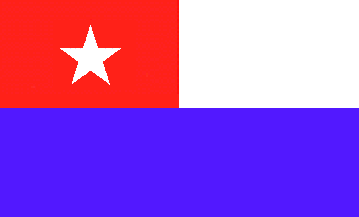
The “Cespedes Flag” of Cuba.
In Cuba – Cespedes Flag (1868) it’s significance is explained as follows:
The flag was used by Carlos Manuel de Cespedes, known as the Father of Cuba, in his famous uprising known as the “Grito de Yara” of October 10, 1868. This uprising initiated the 10 Year War during which this flag was the flag of Cuban “Independentistas” or pro independence fighters. The 10 Year War ended in 1878 with a truce that allowed Spainish rule over Cuba to continue.
When Cuba became independent from Spain on May 20, 1902, this flag was officially designated the flag of the city of his birth: Bayamo, Oriente, and the flag which Venezuelan-born, Cuban patriot, Narciso Lopez flew in the city of Cárdenas on May 19, 1850, was officially designated the Cuban national flag. In honor of Cespedes and the bravery of the residents of Bayamo, who during the 10 Year War burned the prosperous city to the ground and moved to the forrest rather than surrender it to the Spaniards, Bayamo was proclaimed a “National Monument” and from then on would have its name proceeded by the initials M.N. for “Monumento Nacional.” Since Cuba gained independence from Spain, the flag of Bayamo is displayed alongside the Cuban national flag at official ceremonies and events.
Dr. Eladio José Armesto, 1 April 2002
So, the two great historical flags of Cuba were both inspired by the flag of Texas! Incidentally, note how the history of the Cuban revolution echoes in so many ways our own, with an on-again, off-again quality to it, ending with temporary success with the help of the Americans, yet both countries ending up protectorates of the United States.
So far, we have red, white, and blue as our common Filipino, Cuban, and Puerto Rican heritage from the United States, with a double-heritage of colors also owed to the Texan flag, as well as the use of stripes, borrowed by Texas from the American flag. We have, as the Filipino and Puerto Rican heritage, the use of a Masonic triangle. But where did the idea of the Masonic triangle originate, for flag use? An interesting note in a past FOTW discussion list message were the designs for provincial flags used in the Philippines during Spanish times.


Philippines, maritime flag ; Iloilo, maritime flag
Both flags circa the 1850s, used for navigation in Philippine waters, from what I understand from messages in the FOTW mailing list. Incidentally, the same navigational flag for Havana, Cuba, was this:![]()
Ignore the black part of the flags; imagine the square end attached to the flagpole, and the end being what is called swallow-tailed. Now, if you reversed the flag, that is, get the end with two points, and fill in the gap (what is black in the images), and stick that on the flag pole, you get:

The flag of the Philippines, formally unfurled on June 12, 1898. This is an illustration by a book by Carmen Guerrero Nakpil, one of the champions of changing the blue color of the flag to Cuban blue. The elements then, are as follows: the triangle and stripes from the Spanish navigational flags, as adapted by the Cubans, who also borrowed the colors of the Texan and American flags. Our own borrowing, independent of the Cuban example, is the mythical sun, which you can see in the following Latin American republics (images taken from FOTW):
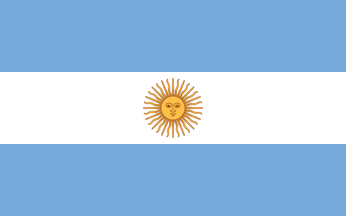

Argentina ; Presidential flag of Chile
And most startling of all, from Cuba – Historical Flags: this flag, used by a Masonic society known as the “Suns and Rays of Bolivar” in 1823:
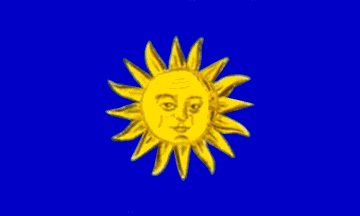
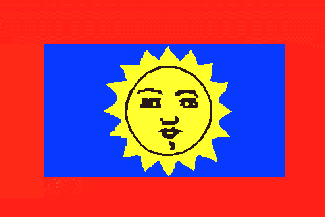
The “Suns and Rays” flag ; Simon Bolivar’s own design for the “union of Cuba.”
Simón BolÃÂvar – Wikipedia, the free encyclopedia: explains who Bolivar was, needless to say, he was one of the greatest heroes of Central and South American liberation from Spain. Which means, our flag, by way of Cuba, owes its sun, as Argentina, Chile and other countries do, to the Great Liberator Bolivar!
As for the color blue, more on that some other time. For now, suffice it to say that the Philippines is not alone in debating the correct shade of blue for its flag. Cuba and Puerto Rico, apparently, have been grappling with the same issue.
A final note: the flags of the world can be divided into families, each family tracing its origin in turn, to other flags that served as inspirations for nationalist and other movements. The most obvious examples are the flag families of France (Mexico, Italy, Ireland, many African countries, to name but a few); Holland (Russia, South Africa, to name just a couple); the United States (Malaysia, Liberia, Chile, to name a few); the Soviet Union (China, Vietnam, etc.). Flag designers looked to the flags of other nations for inspiration and meaning. So, it isn’t all that odd that the Philippine flag was inspired by that of Cuba and the United States, or that this was clearly intended at the time. Cuba, for example, firmly Communist, and which is not a great lover of the United States, to this day acknowledges and doesn’t hide the historical origins of its national flag (which, after all, was kept by Fidel Castro even after the success of the Cuban revolution).
Speaking about Wikipedia, most of the flag images we have used were taken from the American CIA. While I am disgusted at the images (and replaced a few myself), it feels like because we use these inaccurate flags, many of these images are being copied all over the internet. I think that as Wikipedia allows better technology to be used in making images, you and the entire world will see better results, and I can put out better artwork than ever before.
Cool site. Thank you!
Very good site. Thanks!
what is the meaning of the colors because that explains NADA IM 13 IM PUERTO RICAN I KNOW I SHOULD KNOW THIS BUT YOUR WEB SITE TELLS ME NOTHING DAMN IT!!!!!!!!!!!!!!!!!!
Hello! Good Site! Thanks you! efknddblkxutbz
this didn’t really help me at all i just want to know why the flags are so similar and also why they are similar to the american flag
“History & Symbolism of the Puerto Rican Flag”
http://blog.myspace.com/index.cfm?fuseaction=blog.view&friendID=45761324&blogID=254562162
e putangina ang dami flag e ano ba talaga??